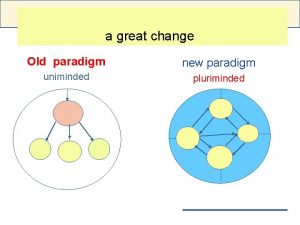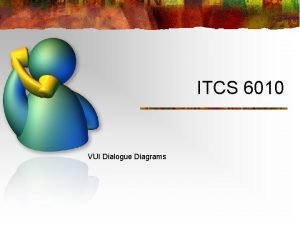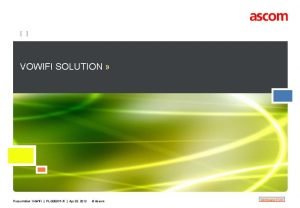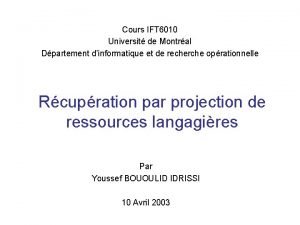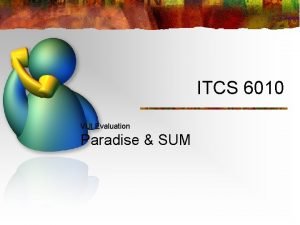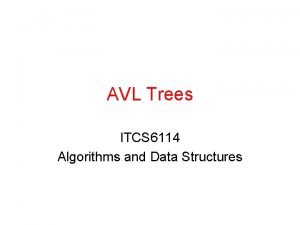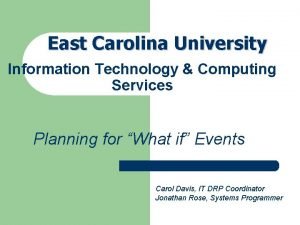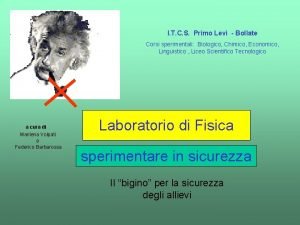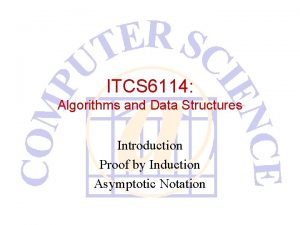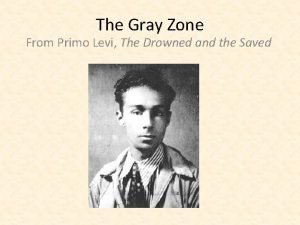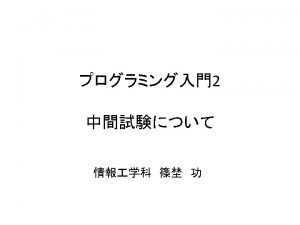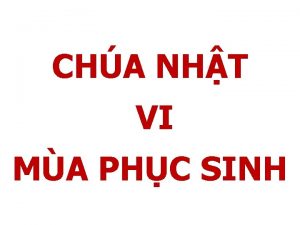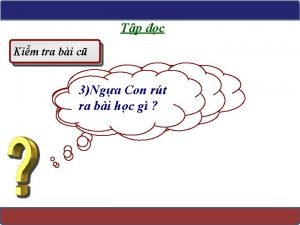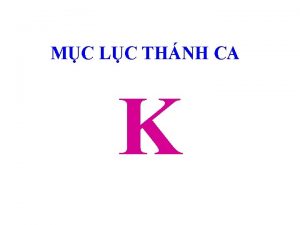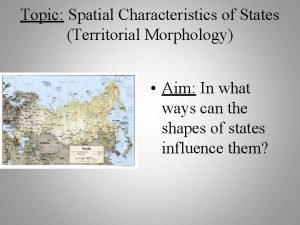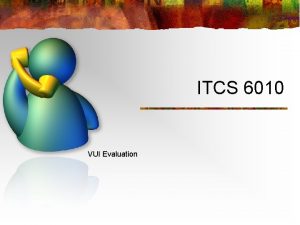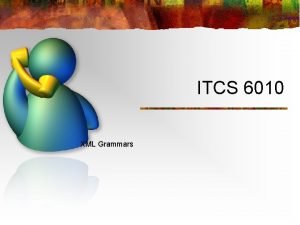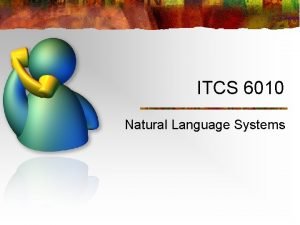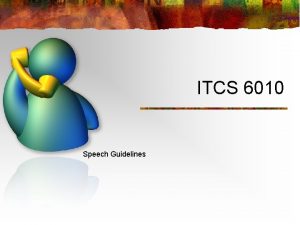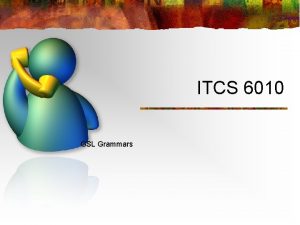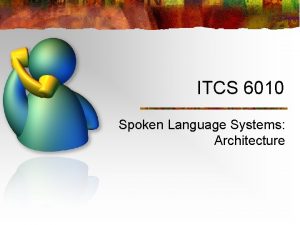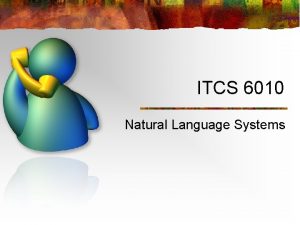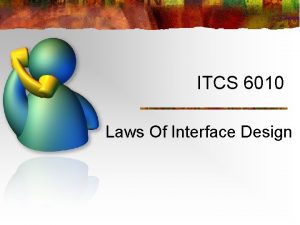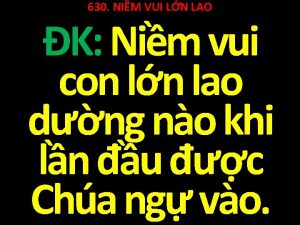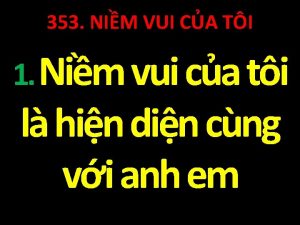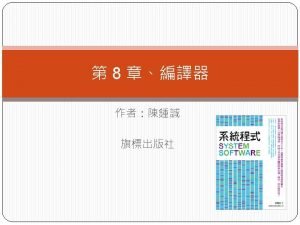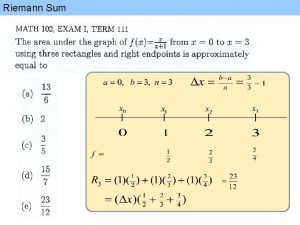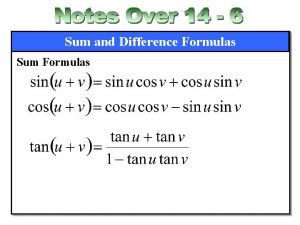ITCS 6010 VUI Evaluation Paradise SUM PARADISE Paradigm


















- Slides: 18

ITCS 6010 VUI Evaluation Paradise & SUM

PARADISE Paradigm for Dialogue System Evaluation n Goal: Maximize User Satisfaction

PARADISE Paradigm for Dialogue System Evaluation n Performance is modeled as a weighted function of a task-based success measure and dialogue-based cost measures, where weights are computed by correlating user satisfaction with performance. n Dialogue tasks are represented as Attribute Value Matrix (AVM) pairs.

Attribute Value Matrix (AVM) n AVM represents dialogue task n n n Information exchange between agent and user Represented as ordered pairs of attribute and possible values AVM instantiation of task n Same regardless of dialogue

AVM (cont’d) A 1: Hello this is Train Enquiry Service. DC, AC, DR, DT Please speak after the tone. Which information do you need? U 1: I want to go from Torino to Milano. DC, AC A 2: Do you want to go from Trento to DC, AC Milano? Yes or No? U 2: No. DC, AC A 3: Do you want to leave from Trento? Yes if No? DC U 3: No. DC A 4: Where do you want to leave from? DC U 4: I want to leave from Torino. DC A 5: Do you want to leave from Torino? DC Yes or No? U 5: Yes. DC A 6: Do you want to go to Milano? AC U 6: Yes. AC A 7: At which time do you want to leave? DR U 7: I want to travel in the evening. DR A 8: Do you want to leave between 6 and 9 pm? Yes or No? DR U 8: Yes. DR A 9: There is a train leaving at 8: 00 pm. DT …. B 1: Hello this is Train Enquiry Service. Please speak after the tone. Which information do you need? U 1: I want to travel from Torino to Milano. B 2: At which time do you want to leave from Merano to Milano? U 2: No, I want to leave from Torino in the evening. B 3: Do you want to leave from Torino between 6 and 11 pm? Please answer Yes or No. U 3: Yes. B 4: A train leaves at 8: 00 pm. …. attribute actual value depart-city Torino arrival-city Milano depart-range Evening depart-time 8 pm DC, AC, DR, DT DC, AC, DR DC, DR DT

PARADISE Paradigm for Dialogue System Evaluation n Advantages n n PARADISE approach addresses performance and user satisfaction Disadvantages n n Too complex to compute. Need a large sample size up front

Alternative Approaches n What’s important? n n Maximize User Satisfaction Maximize Task Success

User Satisfaction n How do we measure user satisfaction? n Questionnaires n Interviews n Focus Groups

Task Success n How do we measure task success? n Logging Actual Use n Performance Measurement n Walkthroughs n Pilot Testing

Task Success n For each dialogue and the entire conversation establish AVMs. n Measure task success with respect to: n n Task completion time Accuracy or Errors (e. g. misinterpretations)


Conclusions n PARADISE is good, but too complex! n Measure user satisfaction and task success. n What if user satisfaction not most relevant aspect?

Speech Usability Metric (SUM) n Uses 3 metrics: n n User satisfaction Accuracy Task completion time Eliminates restriction of one factor to determine usability

Speech Usability Metric (SUM) n SUM = X * User Satisfaction + Y * Accuracy + Z * Completion Time n n n X+Y+Z=1 X, Y, Z > 0 Weights determined by evaluator

User Satisfaction n Surveys n Questionnaires n Interviews

Accuracy n Misinterpretations n n Out-of-vocabulary errors n n System recognizes wrong word Words not in system grammar Wrong choice n Correct word recognized, wrong path chosen

Task Completion Time n n Time to complete task Time for expert to complete task (ETCT) Maximum time to complete task (MTCT) Expected time to complete task (Ex. TCT)

Conclusion n SUM determines usability of a speech application n n Utilizes 3 pre-defined metrics Allows for greater flexibility
 Old paradigm vs new paradigm examples
Old paradigm vs new paradigm examples Minsex
Minsex Mng-6010
Mng-6010 Jbl kp 6010
Jbl kp 6010 Vo 6010
Vo 6010 Ift 6010
Ift 6010 Mng-6010
Mng-6010 Itcs 6114
Itcs 6114 Ecu itcs
Ecu itcs Itcs primo levi
Itcs primo levi Itcs 6114
Itcs 6114 The gray zone primo levi
The gray zone primo levi Sum0
Sum0 Mừng vui lên sion
Mừng vui lên sion Tôi vui mừng tiến bước về nhà cha
Tôi vui mừng tiến bước về nhà cha Cùng vui chơi
Cùng vui chơi Trần gian tăm tối tìm đâu thấy niềm vui
Trần gian tăm tối tìm đâu thấy niềm vui Vui-qgcfxua -site:youtube.com
Vui-qgcfxua -site:youtube.com Mừng vui lên anh em vì chúa đến làm người
Mừng vui lên anh em vì chúa đến làm người
